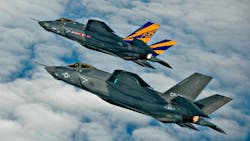Air Force wants directional RF communications for tactical airborne networking of high-performance aircraft
ROME, N.Y. – U.S. Air Force researchers are asking industry for enabling technologies the involve next-generation, highly directional, networked aerial layer communications for tactical airborne networking.
Officials of the Air Force Research Laboratory Information Directorate in Rome, N.Y., re-issued a broad agency announcement (FA875020S7003) on Friday for the Next-Generation Airborne Directional Networking program.
Directional networking focuses a substantial amount of radiated energy on an intended receiver to resist interference and increase link capacity. It also reduces stray energy radiated in directions other than the intended receiver to reduce interference and reduce the possibility of enemy intercept or eavesdropping.
Some experts confuse directional airborne tactical networking with land-based mobile ad-hoc networks (MANETs), yet these two communications modes are dramatically different.
Compared with MANET technology, airborne tactical networking involves entirely vehicle-based systems. This removes power consumption and equipment constraints otherwise imposed by battery-operated handheld devices like MANETs use.
Although less severe than handheld operation, airborne platforms still present size, weight, power consumption, and cost (SWAP-C) challenges as well as entirely different vibration and environmental requirements.
The different loss characteristics of airborne tactical networking enable greater range than MANETs, and enable any participant in the network to be directly. This increases the likelihood of challenges from interference. Different altitudes and environmental conditions effect propagation of signals.
Jet fighters and other high-performance aircraft also move much faster than land vehicles, which also may require the ability to compensate for Doppler effects, propagation times, and synchronization. Jets also may need apertures and RF electronics able to switch and point rapidly.
Other issues of airborne networking include topology management and scheduling; network discovery while maintaining a low probability of detection; ad-hoc network join/leave; directional routing and media access control; survivable airborne communication technologies; modular and open-architecture systems; intelligent information services; flexible directional apertures; and multifunction RF systems.
From industry, Air Force researchers want white papers for research, development, integration, test, evaluation, and delivery of technologies for next-generation, highly-directional, networked aerial layer communications.
Those submitting good white papers may be invited to submit formal proposals. Researchers will accept white papers until 29 Sept. 2023, although companies have a better chance of acceptance if they submit white papers earlier.
Companies may submit white papers for first consideration by 4 July 2021, and by 3 July 2022. This solicitation originally was issued in November 2019.
Companies interested should email white papers to the Air Force's Richard Butler at [email protected].
Email business or contractual questions to Amber Buckley at [email protected]. More information is online at https://beta.sam.gov/opp/08a732e7306c438bb1a90f2565a2f406/view.
About the Author
John Keller
Editor-in-Chief
John Keller is the Editor-in-Chief, Military & Aerospace Electronics Magazine--provides extensive coverage and analysis of enabling electronics and optoelectronic technologies in military, space and commercial aviation applications. John has been a member of the Military & Aerospace Electronics staff since 1989 and chief editor since 1995.
